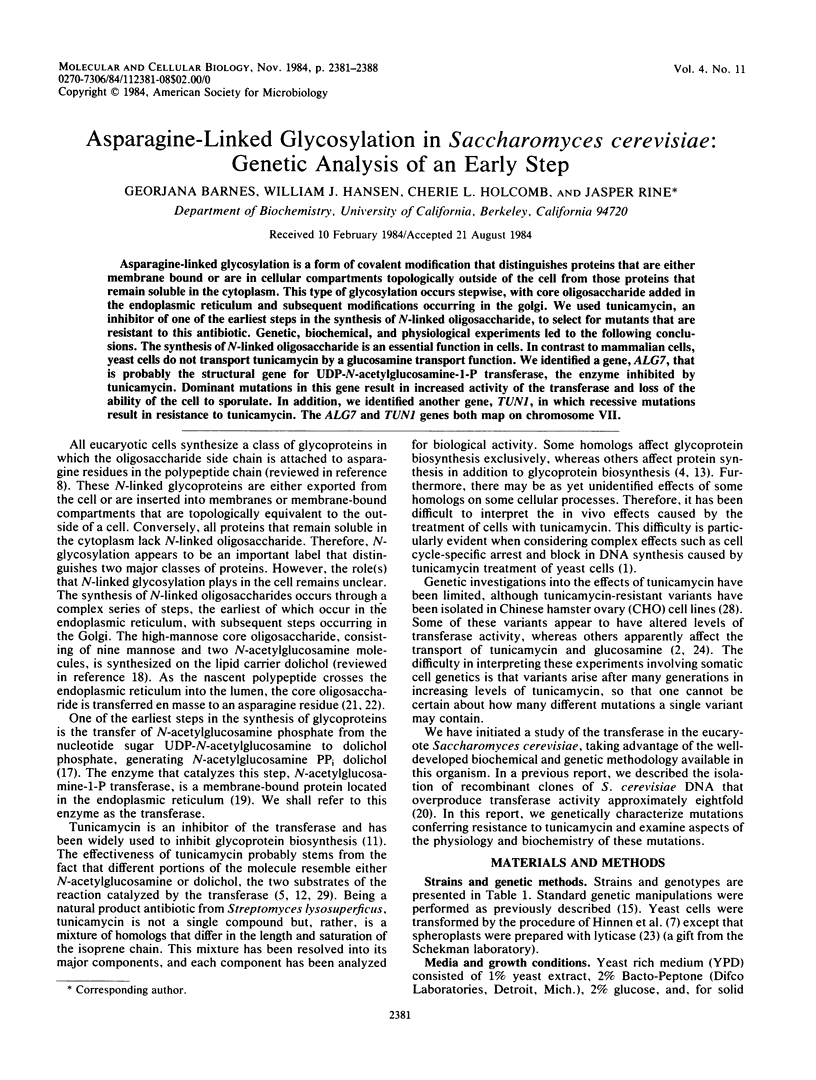Asparagine-linked glycosylation in Saccharomyces cerevisiae: genetic analysis of an early step (original) (raw)
Abstract
Asparagine-linked glycosylation is a form of covalent modification that distinguishes proteins that are either membrane bound or are in cellular compartments topologically outside of the cell from those proteins that remain soluble in the cytoplasm. This type of glycosylation occurs stepwise, with core oligosaccharide added in the endoplasmic reticulum and subsequent modifications occurring in the golgi. We used tunicamycin, an inhibitor of one of the earliest steps in the synthesis of N-linked oligosaccharide, to select for mutants that are resistant to this antibiotic. Genetic, biochemical, and physiological experiments led to the following conclusions. The synthesis of N-linked oligosaccharide is an essential function in cells. In contrast to mammalian cells, yeast cells do not transport tunicamycin by a glucosamine transport function. We identified a gene, ALG7, that is probably the structural gene for UDP-N-acetylglucosamine-1-P transferase, the enzyme inhibited by tunicamycin. Dominant mutations in this gene result in increased activity of the transferase and loss of the ability of the cell to sporulate. In addition, we identified another gene, TUN1, in which recessive mutations result in resistance to tunicamycin. The ALG7 and TUN1 genes both map on chromosome VII.

Images in this article
Selected References
These references are in PubMed. This may not be the complete list of references from this article.
- Arnold E., Tanner W. An obligatory role of protein glycosylation in the life cycle of yeast cells. FEBS Lett. 1982 Nov 1;148(1):49–53. doi: 10.1016/0014-5793(82)81240-4. [DOI] [PubMed] [Google Scholar]
- Criscuolo B. A., Krag S. S. Selection of tunicamycin-resistant Chinese hamster ovary cells with increased N-acetylglucosaminyltransferase activity. J Cell Biol. 1982 Sep;94(3):586–591. doi: 10.1083/jcb.94.3.586. [DOI] [PMC free article] [PubMed] [Google Scholar]
- Duksin D., Mahoney W. C. Relationship of the structure and biological activity of the natural homologues of tunicamycin. J Biol Chem. 1982 Mar 25;257(6):3105–3109. [PubMed] [Google Scholar]
- Ericson M. C., Gafford J. T., Elbein A. D. Tunicamycin inhibits GlcNAc-lipid formation in plants. J Biol Chem. 1977 Nov 10;252(21):7431–7433. [PubMed] [Google Scholar]
- Ferro-Novick S., Hansen W., Schauer I., Schekman R. Genes required for completion of import of proteins into the endoplasmic reticulum in yeast. J Cell Biol. 1984 Jan;98(1):44–53. doi: 10.1083/jcb.98.1.44. [DOI] [PMC free article] [PubMed] [Google Scholar]
- Hinnen A., Hicks J. B., Fink G. R. Transformation of yeast. Proc Natl Acad Sci U S A. 1978 Apr;75(4):1929–1933. doi: 10.1073/pnas.75.4.1929. [DOI] [PMC free article] [PubMed] [Google Scholar]
- Hubbard S. C., Ivatt R. J. Synthesis and processing of asparagine-linked oligosaccharides. Annu Rev Biochem. 1981;50:555–583. doi: 10.1146/annurev.bi.50.070181.003011. [DOI] [PubMed] [Google Scholar]
- Huffaker T. C., Robbins P. W. Temperature-sensitive yeast mutants deficient in asparagine-linked glycosylation. J Biol Chem. 1982 Mar 25;257(6):3203–3210. [PubMed] [Google Scholar]
- Klebl F., Huffaker T., Tanner W. A temperature-sensitive N-glycosylation mutant of S. cerevisiae that behaves like a cell-cycle mutant. Exp Cell Res. 1984 Feb;150(2):309–313. doi: 10.1016/0014-4827(84)90573-1. [DOI] [PubMed] [Google Scholar]
- Kuo S. C., Lampen J. O. Tunicamycin--an inhibitor of yeast glycoprotein synthesis. Biochem Biophys Res Commun. 1974 May 7;58(1):287–295. doi: 10.1016/0006-291x(74)90925-5. [DOI] [PubMed] [Google Scholar]
- Lehle L., Tanner W. The specific site of tunicamycin inhibition in the formation of dolichol-bound N-acetylglucosamine derivatives. FEBS Lett. 1976 Nov 15;72(1):167–170. doi: 10.1016/0014-5793(76)80922-2. [DOI] [PubMed] [Google Scholar]
- Mahoney W. C., Duksin D. Biological activities of the two major components of tunicamycin. J Biol Chem. 1979 Jul 25;254(14):6572–6576. [PubMed] [Google Scholar]
- Mortimer R. K., Contopoulou R., Schild D. Mitotic chromosome loss in a radiation-sensitive strain of the yeast Saccharomyces cerevisiae. Proc Natl Acad Sci U S A. 1981 Sep;78(9):5778–5782. doi: 10.1073/pnas.78.9.5778. [DOI] [PMC free article] [PubMed] [Google Scholar]
- Mortimer R. K., Schild D. Genetic map of Saccharomyces cerevisiae. Microbiol Rev. 1980 Dec;44(4):519–571. doi: 10.1128/mr.44.4.519-571.1980. [DOI] [PMC free article] [PubMed] [Google Scholar]
- Palamarczyk G., Lehle L., Mankowski T., Chojnacki T., Tanner W. Specificity of solubilized yeast glycosyl transferases for polyprenyl derivatives. Eur J Biochem. 1980 Apr;105(3):517–523. doi: 10.1111/j.1432-1033.1980.tb04527.x. [DOI] [PubMed] [Google Scholar]
- Parodi A. J., Leloir L. F. The role of lipid intermediates in the glycosylation of proteins in the eucaryotic cell. Biochim Biophys Acta. 1979 Apr 23;559(1):1–37. doi: 10.1016/0304-4157(79)90006-6. [DOI] [PubMed] [Google Scholar]
- Ravoet A. M., Amar-Costesec A., Godelaine D., Beaufay H. Quantitative assay and subcellular distribution of enzymes acting on dolichyl phosphate in rat liver. J Cell Biol. 1981 Dec;91(3 Pt 1):679–688. doi: 10.1083/jcb.91.3.679. [DOI] [PMC free article] [PubMed] [Google Scholar]
- Rine J., Hansen W., Hardeman E., Davis R. W. Targeted selection of recombinant clones through gene dosage effects. Proc Natl Acad Sci U S A. 1983 Nov;80(22):6750–6754. doi: 10.1073/pnas.80.22.6750. [DOI] [PMC free article] [PubMed] [Google Scholar]
- Rothman J. E., Katz F. N., Lodish H. F. Glycosylation of a membrane protein is restricted to the growing polypeptide chain but is not necessary for insertion as a transmembrane protein. Cell. 1978 Dec;15(4):1447–1454. doi: 10.1016/0092-8674(78)90068-5. [DOI] [PubMed] [Google Scholar]
- Rothman J. E., Lodish H. F. Synchronised transmembrane insertion and glycosylation of a nascent membrane protein. Nature. 1977 Oct 27;269(5631):775–780. doi: 10.1038/269775a0. [DOI] [PubMed] [Google Scholar]
- Scott J. H., Schekman R. Lyticase: endoglucanase and protease activities that act together in yeast cell lysis. J Bacteriol. 1980 May;142(2):414–423. doi: 10.1128/jb.142.2.414-423.1980. [DOI] [PMC free article] [PubMed] [Google Scholar]
- Stinchcomb D. T., Mann C., Davis R. W. Centromeric DNA from Saccharomyces cerevisiae. J Mol Biol. 1982 Jun 25;158(2):157–190. doi: 10.1016/0022-2836(82)90427-2. [DOI] [PubMed] [Google Scholar]
- Stinchcomb D. T., Struhl K., Davis R. W. Isolation and characterisation of a yeast chromosomal replicator. Nature. 1979 Nov 1;282(5734):39–43. doi: 10.1038/282039a0. [DOI] [PubMed] [Google Scholar]
- Sudo T., Onodera K. Isolation and characterization of tunicamycin resistant mutants from Chinese hamster ovary cells. J Cell Physiol. 1979 Oct;101(1):149–156. doi: 10.1002/jcp.1041010117. [DOI] [PubMed] [Google Scholar]
- Whelan W. L., Ballou C. E. Sporulation in D-glucosamine auxotrophs of Saccharomyces cerevisiae: meiosis with defective ascospore wall formation. J Bacteriol. 1975 Dec;124(3):1545–1557. doi: 10.1128/jb.124.3.1545-1557.1975. [DOI] [PMC free article] [PubMed] [Google Scholar]